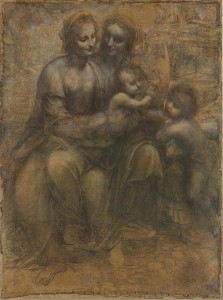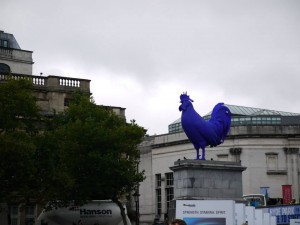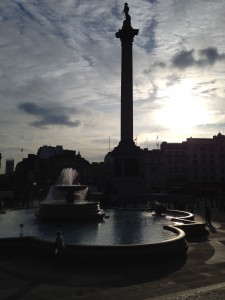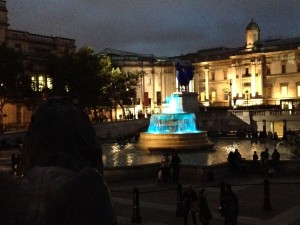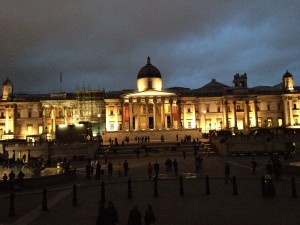Let’s face it, we’re only discussing Trafalgar Square because how else do you fit the words “blue cock” into legitimate conversation?
There’s a lot going on in Trafalgar Square: the National Gallery, Nelson’s Column, and the plinths are the usual suspects. Nelson’s Column is really cool, but you can’t spit in London without hitting a monument of one kind or another, so the focus here is on the National Gallery and the Fourth Plinth.
The National Gallery is one of those few places that frown upon picture taking, etc., so I got nothin’ to show you. But it is a super cool gallery if you’re into the whole “art” thing. Monet, Degas, van Gogh, Da Vinci… Best field trip ever!
I used to go to art school, and I’ve always really liked the arts of all mediums, so the Gallery wouldn’t have been a total bust for me no matter what, but what really made me happy was getting to see this:
For whatever reason, this has always been my favourite piece by Da Vinci. It’s a cartoon: a drawing on several sheets of paper that was to be eventually used as a template for a later piece. Da Vinci never actually moved beyond the half-finished cartoon, though.
But this was supposed to be about cocks, not Jesus, so…
The Fourth Plinth.
The Fourth Plinth in Trafalgar square is used as a centerpiece for modern art, as opposed to the other three plinths, which all have other, “normal” things on them—namely statues of actual people who did actual things. What exactly is on the Plinth changes in a revolving cycle—artists submit their pieces in a contest and the winner gets their design on the Plinth. The last cycle began last July, when Katharina Fritsch’s Hahn/Cock was selected. Everyone just calls it “the blue cock,” though. Because…well… That’s what it is.
The next two installments have already been selected, and while the giant thumbs-up is…well…it’s a giant thumb, the skeletal horse of DOOM (and…economics…?) looks pretty fab.
Okay, fine, we’ll talk about the Column…
It was built in 1840-43 and commemorates Admiral Horatio Nelson, who died in 1805 in the Napoleonic Wars during the Battle of Trafalgar. The lions around the base were constructed twenty-odd years later. The end.

Emma, Ellicia, Miguel, Tom, and I all went traipsing around Central London one evening and eventually ended up sitting on the base of Nelson’s Column. We’re not going to talk about how hard it was for me to get up there….

